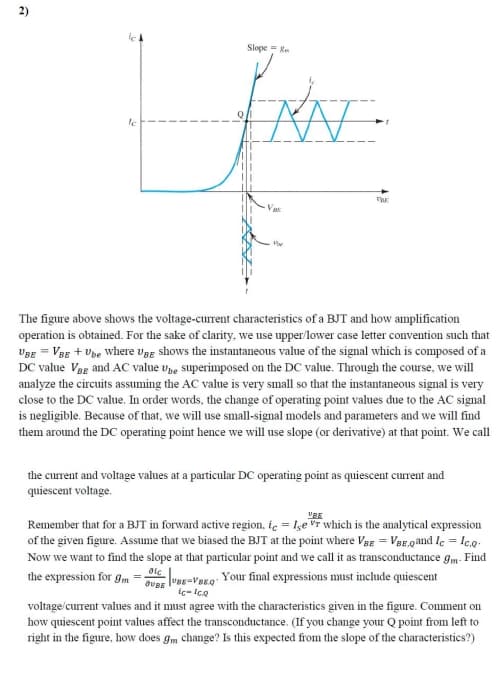le Vas he re above shows the voltage-current characteristics of a BJT and how amplification a is obtained. For the sake of clarity, we use upper/lower case letter convention su e + Upe where ugg shows the instantaneous value of the signal which is compose e Veg and AC value Vhe Superimposed on the DC value. Through the course, we he circuits assuming the AC value is very small so that the instantaneous signal i the DC value. In order words, the change of operating point values due to the AC ible. Because of that, we will use small-signal models and parameters and we wil und the DC operating point hence we will use slope (or derivative) at that point.
le Vas he re above shows the voltage-current characteristics of a BJT and how amplification a is obtained. For the sake of clarity, we use upper/lower case letter convention su e + Upe where ugg shows the instantaneous value of the signal which is compose e Veg and AC value Vhe Superimposed on the DC value. Through the course, we he circuits assuming the AC value is very small so that the instantaneous signal i the DC value. In order words, the change of operating point values due to the AC ible. Because of that, we will use small-signal models and parameters and we wil und the DC operating point hence we will use slope (or derivative) at that point.
Introductory Circuit Analysis (13th Edition)
13th Edition
ISBN:9780133923605
Author:Robert L. Boylestad
Publisher:Robert L. Boylestad
Chapter1: Introduction
Section: Chapter Questions
Problem 1P: Visit your local library (at school or home) and describe the extent to which it provides literature...
Related questions
Question
Question is attached as picture.

Transcribed Image Text:2)
Slope = R
le
Va
The figure above shows the voltage-current characteristics of a BJT and how amplification
operation is obtained. For the sake of clarity, we use upper/lower case letter convention such that
Ugg = Vgg + Upe where Vag shows the instantaneous value of the signal which is composed of a
DC value Veg and AC value ve superimposed on the DC value. Through the course, we will
analyze the circuits assuming the AC value is very small so that the instantaneous signal is very
close to the DC value. In order words, the change of operating point values due to the AC signal
is negligible. Because of that, we will use small-signal models and parameters and we will find
them around the DC operating point hence we will use slope (or derivative) at that point. We call
the current and voltage values at a particular DC operating point as quiescent current and
quiescent voltage.
"BE
Remember that for a BJT in forward active region, ic = Ige VT which is the analytical expression
of the given figure. Assume that we biased the BJT at the point where VE = Vae,qand le = Ic.o-
Now we want to find the slope at that particular point and we call it as transconductance gm. Find
the expression for gm
aE lu=Vero: Your final expressions must include quiescent
ic- Ice
voltage/current values and it must agree with the characteristics given in the figure. Comment on
how quiescent point values affect the transconductance. (If you change your Q point from left to
right in the figure, how does gm change? Is this expected from the slope of the characteristics?)
Expert Solution
This question has been solved!
Explore an expertly crafted, step-by-step solution for a thorough understanding of key concepts.
Step by step
Solved in 2 steps with 2 images

Knowledge Booster
Learn more about
Need a deep-dive on the concept behind this application? Look no further. Learn more about this topic, electrical-engineering and related others by exploring similar questions and additional content below.Recommended textbooks for you

Introductory Circuit Analysis (13th Edition)
Electrical Engineering
ISBN:
9780133923605
Author:
Robert L. Boylestad
Publisher:
PEARSON

Delmar's Standard Textbook Of Electricity
Electrical Engineering
ISBN:
9781337900348
Author:
Stephen L. Herman
Publisher:
Cengage Learning

Programmable Logic Controllers
Electrical Engineering
ISBN:
9780073373843
Author:
Frank D. Petruzella
Publisher:
McGraw-Hill Education

Introductory Circuit Analysis (13th Edition)
Electrical Engineering
ISBN:
9780133923605
Author:
Robert L. Boylestad
Publisher:
PEARSON

Delmar's Standard Textbook Of Electricity
Electrical Engineering
ISBN:
9781337900348
Author:
Stephen L. Herman
Publisher:
Cengage Learning

Programmable Logic Controllers
Electrical Engineering
ISBN:
9780073373843
Author:
Frank D. Petruzella
Publisher:
McGraw-Hill Education

Fundamentals of Electric Circuits
Electrical Engineering
ISBN:
9780078028229
Author:
Charles K Alexander, Matthew Sadiku
Publisher:
McGraw-Hill Education

Electric Circuits. (11th Edition)
Electrical Engineering
ISBN:
9780134746968
Author:
James W. Nilsson, Susan Riedel
Publisher:
PEARSON

Engineering Electromagnetics
Electrical Engineering
ISBN:
9780078028151
Author:
Hayt, William H. (william Hart), Jr, BUCK, John A.
Publisher:
Mcgraw-hill Education,